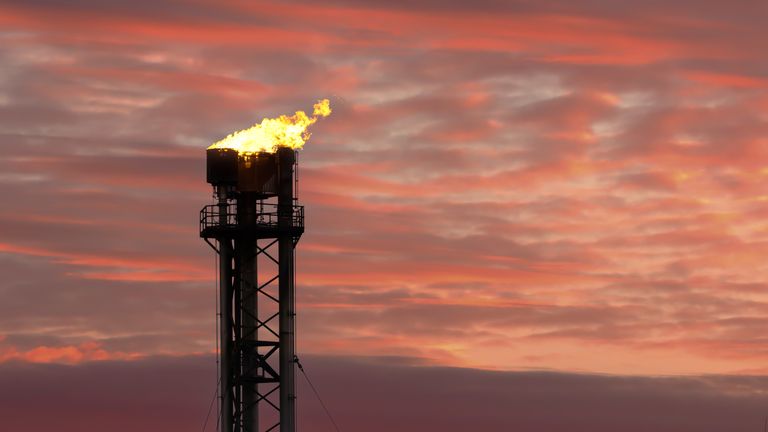Vast scale of methane leaks from fossil fuel production and landfill sites exposed
Around 1,300 "super-emitters" of the potent greenhouse gas have been identified so far in 2023 by the monitoring company Kayrros, which uses satellites to detect plumes of the gas.
Tuesday 5 December 2023 15:04, UK
The vast scale of methane leaks from fossil fuel production and landfill sites has been exposed by analysis carried out exclusively for Sky News.
Around 1,300 "super-emitters" of the potent greenhouse gas have been identified so far in 2023 by the monitoring company Kayrros, which uses satellites to detect plumes of the gas.
It looks for non-natural sources of methane - primarily gas wells, pipelines, coal mines and landfill sites.
According to the data, the largest oil and gas source was on the Cheleken Peninsula in Turkmenistan, where a leak from one facility is estimated to have peaked at 333 tonnes per hour in August.
At that rate the hourly release of methane was equivalent to the greenhouse gas emissions from a car driving around 38,000 miles.
Another leak, from a blown-out drilling well in Kazakhstan, released between 21 and 56 tonnes of the methane every hour for 153 days between June and November.
Coal is also a problem with one facility in Shanxi, China, peaking at around 181 tonnes an hour last February.
And the methane release from buried waste at a landfill site in Dhaka city in Bangladesh peaked at 822 tonnes an hour in April.
Antoine Rostand, co-founder of Kayrros, told Sky News being able to observe emissions from space means there is no hiding.
"Previously we could measure the amount of methane in the atmosphere, but now we really know exactly where it's coming from," he said.
"Which country, which company, which assets are emitting methane in the atmosphere."
Kayrros's data shows Turkmenistan had higher methane emissions than any other nation, followed by the United States, India, Russia and Pakistan.
Methane is the natural gas burned by boilers and other appliances in people's homes.
But if it is released without being burned, often during maintenance on pipelines, it acts as a heat "bomb" in the atmosphere.
The gas causes 80 times more global warming as the same amount of carbon dioxide over a 20-year period.
Click to subscribe to ClimateCast with Tom Heap wherever you get your podcasts
But it also represents a huge opportunity for bending the curve on rising temperatures. Because it only persists in the atmosphere for around a decade rather than several centuries, as in the case of carbon dioxide, turning off the tap on emissions would have a rapid impact.
The United States has announced new rules for fossil fuel companies requiring them to monitor and fix leaks, which should reduce methane emissions by 58 million tonnes between 2024 and 2038.
Mr Rostand said the rules are overdue.
"The have the technology, they have the money, they know exactly what to do," he said.
"They're almost lacking any kind of overall regulation.
"A lot of players are doing a bit but some are not. And this is where regulation plays, because then it will put every single producer on an equal footing."
Be the first to get Breaking News
Install the Sky News app for free


Read more:
Previous decade 'hottest on record'
Why China continues to invest in coal
So far 150 countries have signed up to the Global Methane Pledge, a commitment to reduce emissions by 30% by 2030.
If it is achieved it could reduce the global average temperature by 0.2C and prevent 255,000 premature deaths from extreme heat, according to the Pledge text.
The Kayrros data reveals there are no methane leaks in Europe, but Mr Rostand said the UK and other countries should put more pressure on suppliers of imported natural gas to stop releasing it into the atmosphere.
"It's really a complete waste, because companies can sell it," he said.
"It has an economic value, it's easy to fix. It's the elephant in the room, the low hanging fruit."

